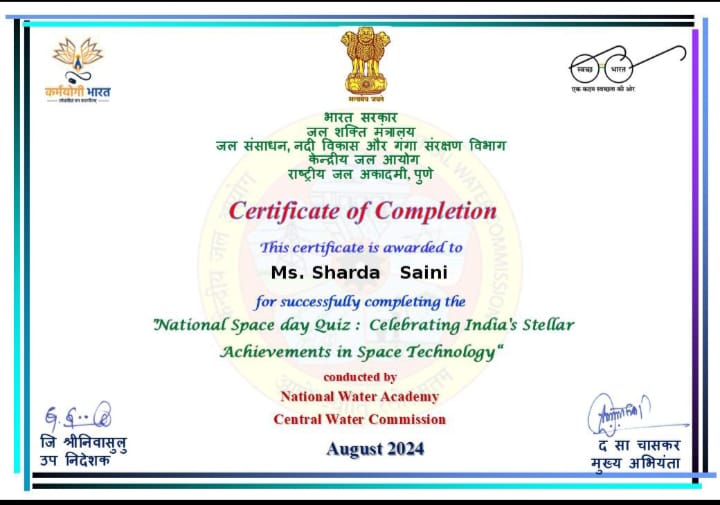
Organizer: National Water Academy (NWA), Central Water Commission, Ministry of Jal Shakti, Department of Water Resources, RD & GR.
About the Quiz
- Quiz on “National Space Day Quiz – Celebrating India’s Stellar Achievement in Space Technology” with an aim to foster awareness and knowledge about India’s remarkable advancements in space technology.
- The quiz will be available from 12th to 21st August 2024
- Free Participants
- Upon completion of the quiz, participants will instantly receive a participation certificate.
Apply Link
100% Correct Answers Here
- Who was the first Indian origin woman in space?*
A) Kalpana Chawla
B) Sunita Williams
C) Rakesh Sharma
D) Valentina Tereshkova - Which Indian mission was the first to send an orbiter to Mars?*
A) Chandrayaan-1
B) Mangalyaan
C) Chandrayaan-2
D) PSLV-C37 - Which planet is known as the Red Planet?*
A) Mars
B) Venus
C) Jupiter
D) Saturn - What is the primary function of a space telescope?*
A) To communicate with astronauts
B) To observe celestial objects
C) To travel to other planets
D) To launch satellites - Which Indian mission was the first to land on the Moon?*
A) Chandrayaan-1
B) Mangalyaan
C) Chandrayaan-2
D) PSLV-C37 - What does the acronym ISRO stand for?*
A) International Space Research Organization
B) Indian Space Research Organisation
C) Interplanetary Space Research Organization
D) Interstellar Space Research Organization - Which planet in our solar system has the most moons?*
A) Earth
B) Mars
C) Jupiter
D) Neptune - Which Indian satellite series is known for using microwave remote sensing? *
A) INSAT
B) GSAT
C) RISAT
D) Cartosat - What was the name of the rocket used by ISRO to launch India’s first satellite, Aryabhata? *
A) SLV
B) PSLV
C) GSLV
D) Cosmos-3M - Which Indian scientist is considered the father of the Indian space program?*
A) Homi J. Bhabha
B) A. P. J. Abdul Kalam
C) Vikram Sarabhai
D) Satish Dhawan. - What is the term for the path an object takes as it revolves around a star, planet, or moon?*
A) Axis
B) Orbit
C) Rotation
D) Revolution - Which planet is known for its prominent ring system?*
A) Neptune
B) Uranus.
C) Saturn
D) Jupiter - What is the main component of the Sun?*
A) Hydrogen
B) Helium
C) Oxygen
D) Carbon - What is the name of the Indian mission that aimed to study the Sun?*
A) Chandrayaan-2
B) Aditya-L1
C) Mangalyaan
D) Astrosat - What is the term for a star that suddenly increases greatly in brightness due to a catastrophic explosion?*
A) Comet
B) Supernova
C) Asteroid
D) Meteor - Which planet is closest to the Sun?*
A) Venus
B) Earth
C) Mars
D) Mercury - Which mission made India the first country to achieve a soft landing near the Moon’s South Pole?*
A) Chandrayaan-1
B) Chandrayaan-2
C) Chandrayaan-3
D) Gaganyaan - Who was the first Indian to travel to space?*
A) Kalpana Chawla
B) Sunita Williams
C) Rakesh Sharma
D) Vikram Sarabhai - What is the difference between a PSLV and a GSLV?*
A) PSLV is for launching satellites into polar orbits, while GSLV is for geostationary orbits
B) GSLV is used for launching lighter payloads
C) PSLV is used only for communication satellites
D) GSLV is used exclusively for scientific research missions - Which planet has the Great Red Spot, a giant storm?*
A) Saturn
B) Jupiter
C) Uranus
D) Neptune - What is the Chandrasekhar limit and its relevance in astrophysics?*
A) The maximum mass a white dwarf star can have before collapsing into a black hole
B) The distance a star can travel before becoming a supernova
C) The speed a spacecraft must reach to escape Earth’s gravity
D) The minimum temperature required for nuclear fusion in a star - Which Indian satellite is known for being the heaviest communication satellite?*
A) GSAT-11
B) INSAT-3DR
C) Cartosat-2
D) RISAT-2B - What phenomenon causes the Northern and Southern Lights?*
A) Solar flares
B) Earth’s magnetic field
C) Asteroid impacts
D) Gravitational waves - What is the main advantage of using liquid propellant rockets?*
A) They are easier to store
B) They provide higher thrust and can be controlled more precisely
C) They are lighter than solid propellant rockets
D) They are more environmentally friendly - What is the term for the boundary around a black hole beyond which no light or other radiation can escape?*
A) Event Horizon
B) Singularity
C) Accretion Disk
D) Schwarzschild Radius
Awareness program
Innovative ideas
Nice quiz
Nice